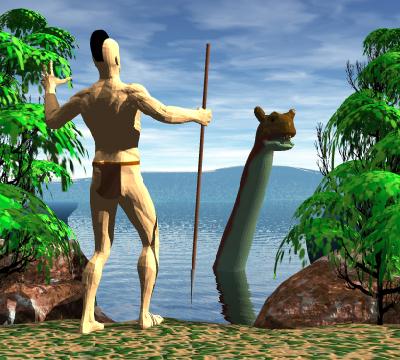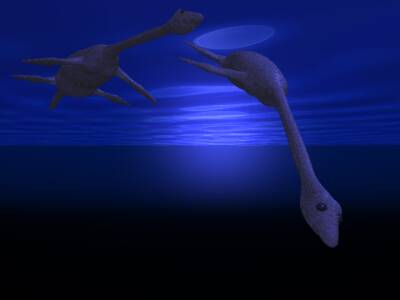pop up description layer
HOME
Cryptozoology UFO Mysteries Aviation Space & Time Dinosaurs Geology Archaeology Exploration 7 Wonders Surprising Science Troubled History Library Laboratory Attic Theater Store Index/Site Map Cyclorama
Search the Site: |
|
Champ of Lake Champlain People the world over have heard of "Nessie," the monster that supposedly inhabits Loch Ness in Scotland. Fewer people are aware that a body of water in North America also has a reputation of having a monster. In Lake Champlain, located on the border between New York and Vermont, the creature, which may be real or legendary, has been given the nickname "Champ." The Iroquois nation lived along the lake before Europeans came. They had stories that said a horned serpent lived within its waters. Many American bodies of water were the source for such legends about water serpents and spirits, and it is difficult to use these as proof of Champ's existence. Some historians place the earliest sighting of the creature by a European with Samual de Champlain, after whom the lake is named. Champlain is supposed to have mentioned the creature in a chronicle he wrote in 1609. A careful reading of the text, though, shows that the animal described by Champlain might have been a large garfish, rather than a monster. Many garfish continue to live in the lake today. Reports of the monster start showing up in newspapers around 1873. According to a story in the New York Times, a railroad work crew was laying track near Dresden, New York, when they saw the head of an "enormous serpent" emerge from the water. After a moment of paralyzing shock, the workmen ran away. The creature, in turn, swam away. Witnesses reported that the animal had bright, silver-like scales that glistened in the sun. The article said, "The appearance of his head was round and flat, with a hood spreading out from the lower part of it like a rubber cap often worn by mariners." In August of that same year, a small steamship loaded with tourists, allegedly struck the creature and nearly turned over. According to newspaper accounts, the head and neck of the animal were sighted afterward about a 100 feet from the ship. As the fame of Champ grew, showman P.T. Barnum posted a $50,000 reward for the "hide of the great Champlain serpent to add to my mammoth World's Fair Show." Reports appeared in the newspapers for the rest of that century. In July of 1883 the Clinton County Sheriff saw "an enormous snake or water serpent" which he estimated to be 25 to 35 feet long. In 1887 a farm boy spotted the creature "making noises like a steamboat" a mile out in the lake. That same year a group of picnickers near Charlotte, Vermont, reported seeing an animal seventy-five feet long and "big around as a barrel" out in the water. All the reports of this era seem to picture the creature as a long serpent with an arched back and a broad, flat tail. In modern times there have also been similar reports about Champ. In 1970 the creature was reported spotted by two independent witnesses traveling on a ferry across the lake. Richard Spear, one witness, said the animal was "dark brownish-olive" in color with "the size and shape of a barrel in cross-section." The other witness said the creature appeared to be "a large snakelike creature, swimming with its head above water, held as snakes do, with coils behind." There have also been other reports that seem to describe the creature resembling a plesiosaur. Plesiosaurs were marine reptiles with long necks,a bulky body, four fins and a long tail. They have been extinct since the age of the dinosaurs ended some 65 million years ago. Probably the most convincing piece of evidence for the existence of Champ is the "Mansi Photograph" taken in 1977. In the 1970's a New York Social Studies teacher, Joseph Zarzynski, took an interest in the Champ sightings and formed the Lake Champlain Phenomena Investigation. Zarzynski and his group organized observations of the lake, and explorations with sonar and even a small robotic submarine. While some of the sonar searches turned up some interesting blips, none of them were conclusive proof of the creature. In 1980 Zarzynski heard about a photograph taken by Sandra Mansi a few years earlier. He approached Mansi and her husband, saw the picture, and was impressed enough with it to show to George Zug of the Department of Vertebrate Zoology at the Smithsonian Institution. Zug said it didn't resemble any known animal in the lake or anywhere else. The Mansi photograph was taken in 1977. Sandra and Anthony Mansi were visiting relatives in Vermont when they stopped along Lake Champlain's edge near the Canadian border. Sandra's children were playing in the lake while the adults watched. While Anthony went back to the car, Sandra noticed some "turbulence" in the water. As she watched, a huge creature with a small head, long neck and a humped back rose out of the lake.The head, which was eight feet above the surface, moved from right to left. To Sandra it appeared to resemble a prehistoric animal. When Anthony returned, he saw it too. Alarmed for Sandra and the children's sale, he and got them out of the water and up the six-foot lake bank. It was at this point Sandra took the photograph with her Instamatic camera. Moments later the creature seemed to sink back into the lake, perhaps startled by a motorboat that was approaching. The whole sighting lasted six or seven minutes. The Mansis', fearing ridicule, never publicized what they had seen, but put the photo into their family album. The negative got lost over the years. A friend who saw it eventually contacted Zarzynski. Zarzynski also showed the photo to B. Roy Frieden of the University of Arizona's Optical Sciences Center. Frieden determined that the photo was not doctored by pasting one image on top of another. Another expert, Paul LeBlond, from the University of British Columbia, estimated from the surrounding wave sizes, that the object in the picture was between twenty-four and seventy-eight feet in length. Investigations continue at Lake Champlain. Cryptozoologist Roy Mackal visited the lake in 1981 and suggested the creature might be a surviving zeuglodon (also known as a Basilosaurus). Thiis a primitive form of whale which had a long snakelike body that would match the description of many of the reports, but not the Mansi photograph. The fossils of such a creature, thought long extinct, were discovered near Charlotte, Vermont, just a few miles from the lake. Skeptics point out that if there are monsters in Lake Champlain, there must certainly be enough of them to have a breeding population. This usually requires 50 adult creatures for the group to survive even in the short run and 500 to keep the population healthy over a long period. Could fifty large lake monsters live year in and year out in Lake Champlain with only a very occasional sighting? Skeptics argue that this is unlikely. Lake Champlain is very much like Loch Ness: It is long, deep, narrow and cold. Scientists have discovered that both bodies of water have an underwater wave called a seiche that can throw debris from the bottom of the lake up to the surface. Some skeptics think this may explain many of the monster sightings. Whether Champ is a zeuglodon, plesiosaur, or seiche wave, one thing remains certain. People living and visiting Lake Champlain will continue to see things in the water and wonder what they might be.. Copyright Lee Krystek, 2000. All Rights Reserved. |
|
Related Links |
|
|




